
18 Sage Green Kitchen Ideas That Feel Fresh, Earthy, and Elegant
Sage green kitchens embody refined tranquility and contemporary sophistication, combining muted cabinetry with crisp white walls for striking contrast. Natural wood floors, gold or brass hardware, and marble counters infuse depth and organic appeal, while botanicals and layered green textiles enhance biophilic harmony. Thoughtful lighting and premium hardware enhance ambiance, making sage green versatile for farmhouse and minimalist designs alike. Discover inspired combinations, fresh textures, and curated details for a kitchen that feels serene, earthy, and elegantly on trend.
Key Takeaways
- Pair sage green cabinetry with crisp white walls and countertops for a high-contrast, modern, and airy kitchen.
- Incorporate natural wood accents and butcher block countertops to create a timeless, earthy palette with organic texture.
- Add gold or brass hardware and pendant lighting for warmth, luxury, and enhanced visual depth.
- Use real or faux botanicals, along with sage-toned textiles, to reinforce a calming and harmonious biophilic design.
- Feature a sage green kitchen island or hand-painted cabinetry as a sophisticated focal point with unique, custom touches.
Refresh Your Cabinets With Sage Green
A sophisticated palette, sage green cabinetry introduces a tranquil yet contemporary edge to kitchen interiors. Designers consistently highlight sage green kitchen ideas for their ability to evoke both serenity and visual interest.
The subtle, muted undertones of sage green create a soothing atmosphere, ideal for those seeking a fresh yet timeless aesthetic. When set against crisp white walls, sage green cabinets achieve a striking contrast, allowing the cabinetry to command attention while preserving an airy ambiance.
Contemporary surfaces such as white marble or quartz countertops further enhance the look, reinforcing modern design sensibilities. Opting for a matte finish on sage green doors accentuates the cabinetry’s nuanced color, contributing to a refined, understated statement.
Adaptable to modern or traditional décors, sage green remains a versatile, enduring choice. Incorporating textured accents, like exposed brick or wood paneling, adds depth and warmth to complement the sage green cabinetry.
Pair Sage Green With Natural Wood Accents
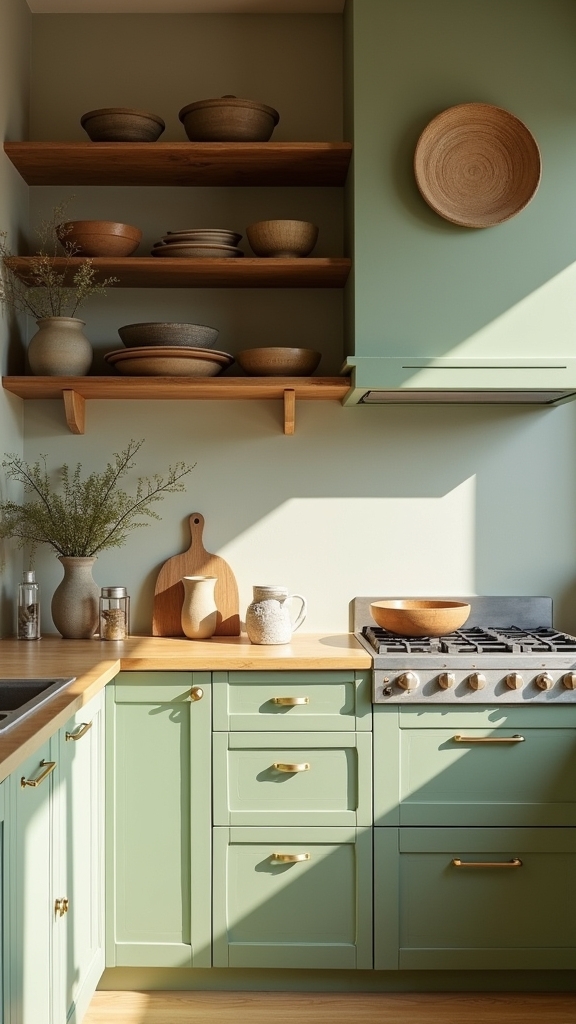
When paired with natural wood accents, sage green kitchens achieve a sophisticated interplay between muted color and organic texture, aligning with emerging trends in biophilic design. Sage green cabinetry juxtaposed with light oak or maple flooring establishes a harmonious, earthy palette that feels both fresh and timeless. The visual tension between the soft, calming hue of sage green and the warm, tactile presence of natural wood creates a dynamic spatial depth. Incorporating elements such as wooden beams, butcher block countertops, or open shelving underscores a curated farmhouse aesthetic while enhancing functionality. This design strategy leverages both materiality and color psychology to evoke a welcoming, grounded atmosphere.
| Sage Green Cabinets | Natural Wood Flooring | Open Shelving |
|---|---|---|
| Muted Elegance | Warm Underfoot | Airy Display |
| Subtle Color Pop | Organic Texture | Accessible Storage |
| Modern-Farmhouse | Inviting Ambience | Visual Lightness |
| Earthy Harmony | Timeless Appeal | Functional Style |
Add Depth With Metallic Gold and Brass Details
Introducing brass handles and fixtures infuses a sage green kitchen with refined warmth and textural contrast, a favored approach in contemporary and heritage-inspired designs.
Gold accents, particularly on hardware and statement lighting, punctuate the muted palette and bring a sense of curated luxury.
Metallic lighting enhancements further amplify depth and visual intrigue, ensuring the space remains both current and inviting.
Incorporating statement gold light fixtures not only complements the sage green tones but also adds an element of sophistication and modernity to the kitchen design.
Brass Handles and Fixtures
Brass handles and fixtures inject warmth and sophistication into sage green kitchens, establishing a striking interplay between the soft, earthy hue and metallic gold accents.
This combination is gaining traction in contemporary kitchen design, where the tactile richness of brass handles contrasts beautifully with the muted serenity of sage cabinetry.
The subtle sheen of brass reflects ambient light, effectively illuminating shadowed corners and enhancing the perception of space.
When integrated through cabinet hardware, faucets, and light fixtures, brass elements evoke a sense of vintage refinement while remaining resolutely modern.
The durability of brass also guarantees longevity in high-traffic areas, making it a practical yet stylish choice.
This nuanced pairing results in kitchens that feel both timeless and on-trend, expertly balancing tradition with current aesthetics.
Gold Accents for Contrast
A judicious infusion of gold accents into a sage green kitchen delivers immediate visual intrigue and depth, acting as a sophisticated counterpoint to the muted, organic base. The interplay between green cabinets and carefully chosen gold or brass details—such as cabinet handles, faucets, and even subtle decor pieces—infuses the setting with warmth and elegance. Brass, in particular, harmonizes with sage tones in both traditional and modern country-inspired kitchens, ensuring a timeless yet on-trend aesthetic. For a nuanced effect, antique brass switches or gold-trimmed vases can punctuate the space, adding vintage allure. Strategic placement of metallics enhances the tranquil ambiance, creating focal points without overpowering the design.
| Element | Emotion Evoked | Visual Impact |
|---|---|---|
| Gold Handles | Warmth | Subtle Contrast |
| Brass Faucets | Sophistication | Timeless Appeal |
| Gold Decor | Serenity | Elegant Accent |
Metallic Lighting Enhancements
Building on the allure of gold accents, metallic lighting emerges as a defining feature in sage green kitchens, balancing visual intrigue with functional elegance.
Metallic lighting enhancements—particularly brass and gold-finished fixtures—introduce luminous warmth and sophisticated contrast to sage green cabinetry. Expertly curated pendant lights or statement chandeliers infuse a space with a harmonious blend of vintage and contemporary sensibilities.
Strategic placement of metallic details, such as handles and taps, draws the eye and establishes focal points, unifying the overall design. Warm metallic lighting with a soft golden glow accentuates sage green’s calming undertones, creating a tranquil, inviting ambiance.
This synergy between sage green and metallic elements reflects a prevailing trend, offering a refined palette suitable for both traditional and modern kitchen aesthetics.
Enhance Serenity With Plants and Green Soft Furnishings
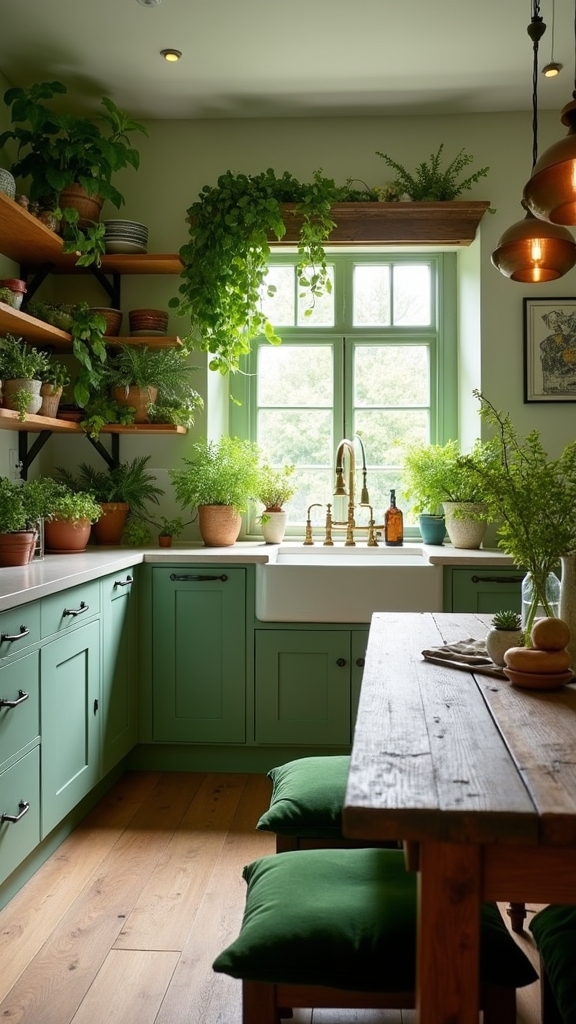
To cultivate a tranquil kitchen atmosphere, designers are increasingly layering sage-toned textiles—such as seat cushions and linens—with thoughtfully placed indoor greenery. This approach not only amplifies visual harmony but also aligns with biophilic design principles, fostering both relaxation and utility. The interplay of soft textures and lush foliage underscores current trends toward serene, nature-inspired interiors. Incorporating eco-friendly materials in your kitchen design can further enhance the sustainable and calming ambiance of the space, promoting both environmental responsibility and a modern aesthetic.
Layer With Sage Textiles
Sage green textiles, such as linen hand towels, cotton seat cushions, and quilted oven gloves, infuse the kitchen with a subtle, on-trend tranquility.
These soft furnishings introduce layers of texture and color, reinforcing the fresh, earthy, and elegant character that defines contemporary kitchen design.
Strategic placement of sage green textiles not only enhances visual interest but also increases comfort and warmth, making the space more inviting.
The interplay between natural fibers—like linen and cotton—and the muted sophistication of sage green creates a harmonious atmosphere that feels both organic and refined.
Pairing these textiles with wooden countertops or stone accents further amplifies the kitchen’s connection to nature, ensuring a cohesive, serene ambiance that remains effortlessly stylish and enduringly relevant.
Incorporate Indoor Greenery
A curated selection of indoor plants introduces a dynamic, biophilic layer to sage green kitchen design, reinforcing the tranquil, nature-inspired palette that defines contemporary interiors.
Integrating real or lifelike botanicals—such as pothos or succulents—elevates visual interest while supporting the calming ambiance that sage green offers. Indoor herb gardens deliver both functional and decorative value, infusing the space with fresh aromas and culinary convenience.
Complementing these living elements with green soft furnishings—think sage-hued hand towels, oven gloves, or seat cushions—creates a seamless chromatic flow, anchoring the kitchen in cohesive serenity.
The current trend emphasizes the synergy between greenery and muted greens, ensuring a space that feels restorative. Thoughtful plant selection guarantees low-maintenance vibrancy, cementing green into your kitchen as a hallmark of sophisticated, contemporary tranquility.
Illuminate With Warm, Thoughtful Lighting

Pendant lighting with warm, low-temperature bulbs instantly enhances the ambiance of a sage green kitchen, casting a welcoming glow that accentuates the room’s tranquil palette.
Expert designers recommend bulbs with a color temperature of 2700K or below to reinforce the inviting warmth characteristic of sage green interiors.
Thoughtful lighting design integrates layered solutions—ambient, task, and accent fixtures—to create visual depth and emphasize cabinetry and décor.
Strategically positioned pendant lights above islands act as focal points, marrying function with aesthetic allure.
The addition of dimmable lighting allows for effortless shifts between bright task settings and intimate, cozy evenings.
For those attuned to current trends, modern industrial fixtures complement country-inspired spaces, delivering sophistication while preserving a warm, thoughtful lighting scheme that enhances the kitchen’s overall elegance.
Incorporate Stone and Marble for Timeless Texture
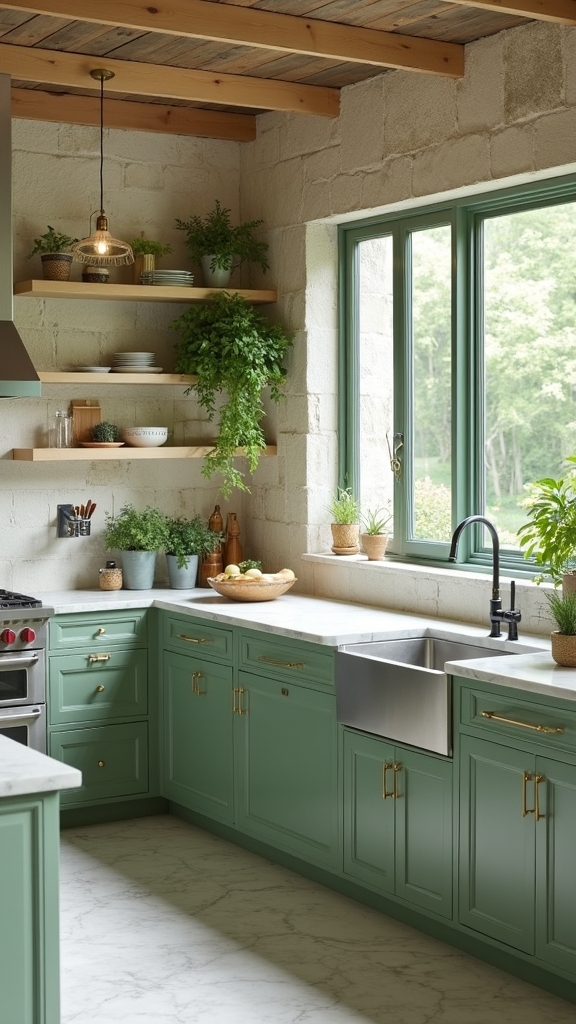
When natural stone and marble are introduced into a kitchen anchored by sage green, the result is a sophisticated interplay of texture and hue that enhances the entire environment.
These materials accentuate the earthy, elegant qualities of sage green, providing both visual depth and tactile interest. The trend-forward application of stone and marble surfaces not only raises the aesthetic but also guarantees durability and easy maintenance—key for modern kitchen functionality.
Their organic patterns and inherent luster harmonize seamlessly with sage green cabinetry, producing a luxurious yet grounded ambiance.
- Pair light marble countertops with sage green cabinets for a fresh, airy contrast and timeless elegance.
- Install textured stone backsplashes to add visual depth and an earthy tactile element.
- Opt for dark stone surfaces to introduce dramatic sophistication while complementing the calming green palette.
Create Contrast With White Walls and Countertops
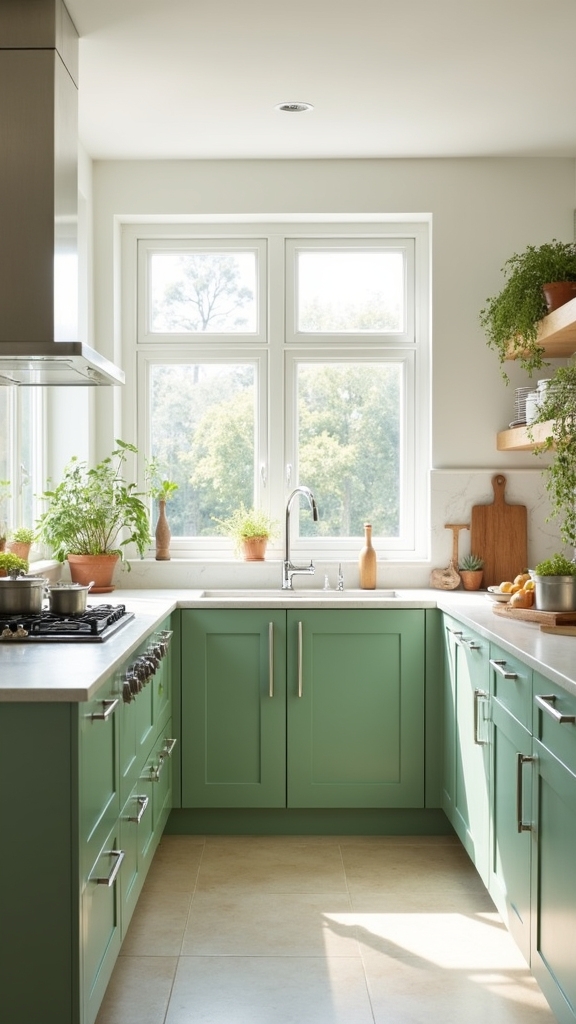
Pairing crisp sage green cabinetry with pristine white walls and countertops delivers a high-contrast palette favored in contemporary kitchen design.
This interplay heightens visual clarity, accentuating the cabinetry’s muted hue while amplifying brightness and spatial openness.
The resulting scheme is both on-trend and timeless, offering a fresh interpretation of classic color contrasts.
Crisp Sage and White
Contrast defines the dynamic interplay between sage green cabinetry and crisp white walls in contemporary kitchen design. This palette leverages the subtle sophistication of sage green against the luminous neutrality of white, generating a space that feels fresh and visually expanded.
The juxtaposition not only enhances spatial perception—making even compact kitchens feel more open—but also seamlessly bridges modern and traditional aesthetics.
- Refined Contrast: Matte sage green cabinets juxtaposed with glossy white walls and countertops deliver a refined yet approachable atmosphere, amplifying both depth and clarity.
- Versatile Style: This color pairing adapts elegantly across diverse decor styles, ensuring longevity whether one prefers modern minimalism or classic traditionalism.
- Elevated Ambience: The light-reflective quality of white surfaces accentuates sage green’s earthy tone, cultivating an airy, elegant kitchen environment.
Bright, Airy Countertop Pairings
Although sage green cabinetry inherently exudes a grounded sophistication, its visual impact is heightened through the integration of bright, airy countertop materials.
White marble or quartz countertops deliver an elegant, contemporary juxtaposition, amplifying both the freshness and luminosity of the kitchen. These bright, airy countertop pairings serve as a crisp backdrop, augmenting the subtle, earthy undertones of matte-finished sage green cabinets.
Incorporating retro white tile or cream stone flooring alongside this palette reinforces a timeless, light-filled ambiance, further expanding the perception of space. This design approach not only aligns with current trends that favor open, inviting environments but also guarantees the kitchen feels modern yet enduring.
Ultimately, the synergy of sage green and luminous countertops achieves a balanced, fashion-forward aesthetic ideal for sophisticated home settings.
Accentuating Cabinet Color Contrast
When sage green cabinetry is juxtaposed with crisp white walls and countertops, the resulting contrast produces a visually dynamic kitchen environment that feels expansive and contemporary.
Accentuating cabinet color contrast in this manner allows the striking green to command attention while maintaining a refined, balanced aesthetic.
White marble or quartz countertops amplify the modern elegance, their polished surfaces reflecting light and enhancing spatial perception.
Matte finishes on the sage green cabinetry further emphasize muted sophistication, ensuring the color interplay is fresh yet understated.
This approach not only enhances the visual appeal but also adapts seamlessly to diverse interior styles.
- Matte sage green cabinets paired with white create a bold, modern statement.
- White marble or quartz counters offer a seamless, upscale contrast.
- Retro white tile or cream stone flooring grounds the look traditionally.
Choose a Sage Green Kitchen Island as a Focal Point
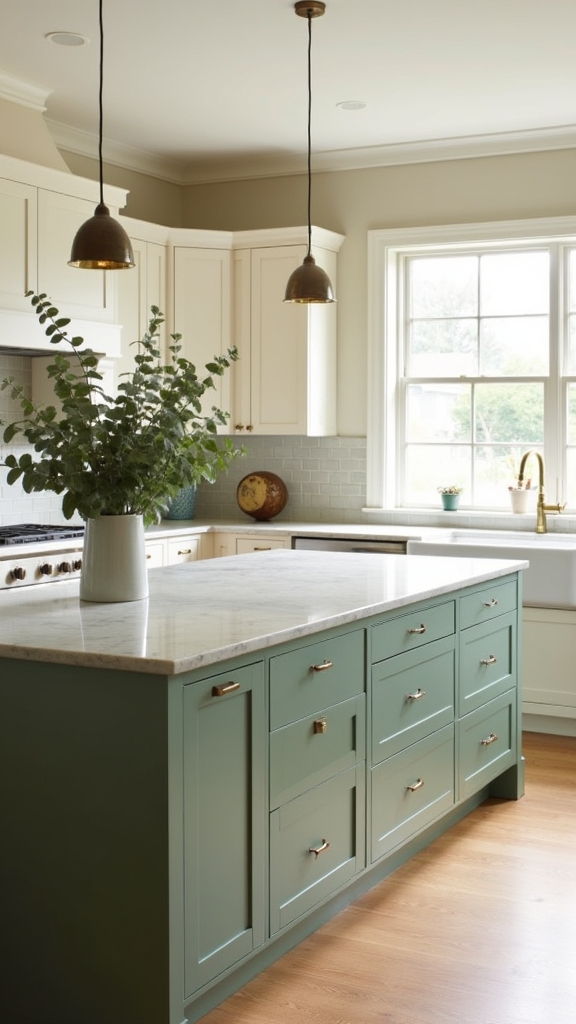
Elevating the kitchen’s visual hierarchy, a sage green island anchors the space with a sophisticated infusion of color that is both calming and invigorating.
As a definitive focal point, the kitchen island in this nuanced hue introduces organic vibrancy, offering a contemporary twist that seamlessly bridges both modern and traditional aesthetics.
The adaptability of sage green guarantees compatibility with light or dark cabinetry, delivering a striking contrast that enhances spatial depth.
Designers increasingly favor sage green islands for their capacity to integrate mixed materials—such as natural wood or stone—further amplifying textural interest.
Functional features like integrated storage or casual seating reinforce the island’s dual role as a style statement and a practical centerpiece.
This trend-forward approach cultivates cohesion, grounding the kitchen’s overall ambiance in earthy elegance.
Hand-Paint Cabinetry for a Custom Touch
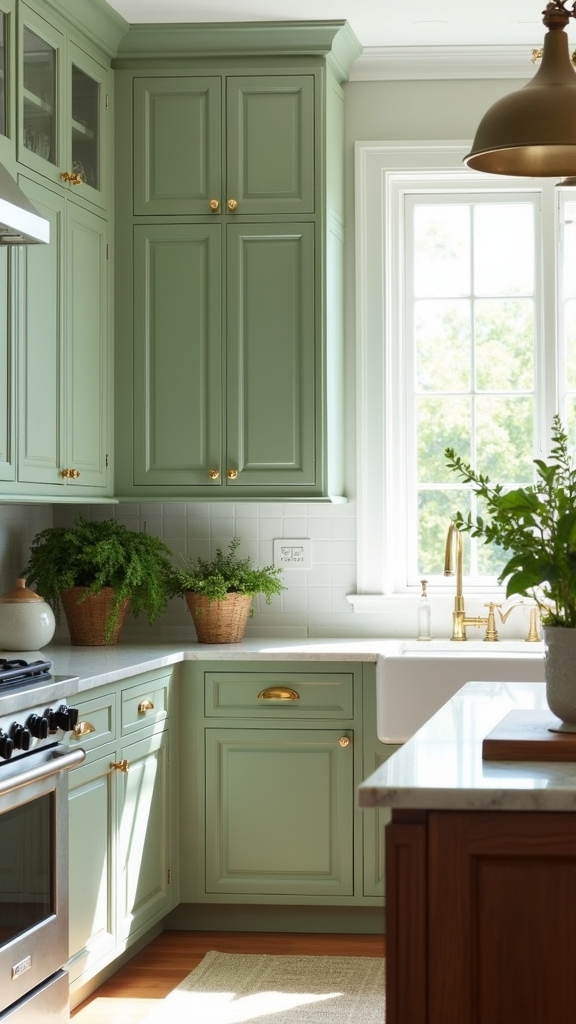
Hand-painted sage green cabinetry infuses the kitchen with bespoke character, signaling a refined appreciation for craftsmanship and individualized design. This technique enhances the space by blending artisanal skill with on-trend color palettes, making each cabinet a distinctive focal point.
The flexibility of hand-painted cabinetry allows for seamless adaptation across diverse kitchen aesthetics, from sleek modernity to classic tradition. Sage green, in particular, introduces a tranquil ambiance, its lighter tones amplifying natural light while its deeper variations pair strikingly with warm brass hardware.
For homeowners seeking a premium, custom touch, hand-painted cabinetry offers both sophistication and versatility.
- Express personal style with endless sage green shade options.
- Enhance luxury with hand-applied finishes and artisanal detailing.
- Easily refresh or update the kitchen palette as trends evolve.
Drench the Space in Sage Green for Cohesion
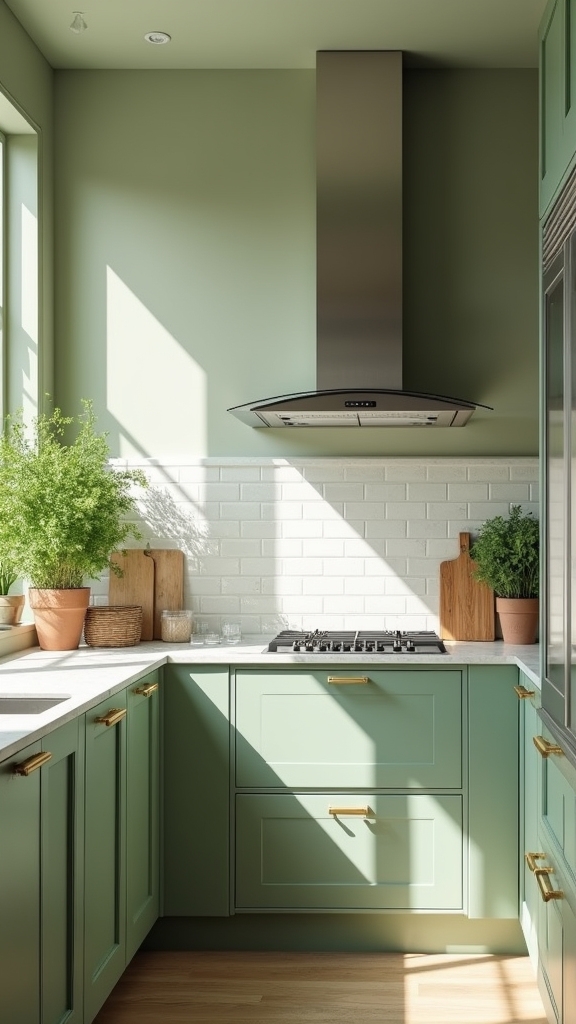
Opting to saturate the kitchen in sage green cabinetry establishes a unified visual narrative, where color seamlessly envelops the space for maximum impact.
This bold approach to kitchen design leverages the tranquil, earthy tones of green to create a harmonious atmosphere that feels both serene and inviting. The monochromatic scheme enhances natural light, imbuing the space with an airy and fresh quality that is highly sought-after in contemporary interiors.
By pairing sage green with warm parquet flooring and copper accents, the design achieves a sophisticated balance between elegance and comfort. Natural wood elements further enrich the space, introducing organic warmth while maintaining cohesion.
This trend-forward strategy enables effortless integration of diverse textures and materials, reinforcing the kitchen’s cohesive, heightened aesthetic without overwhelming the senses.
Introduce Sage Green Backsplash Tiles
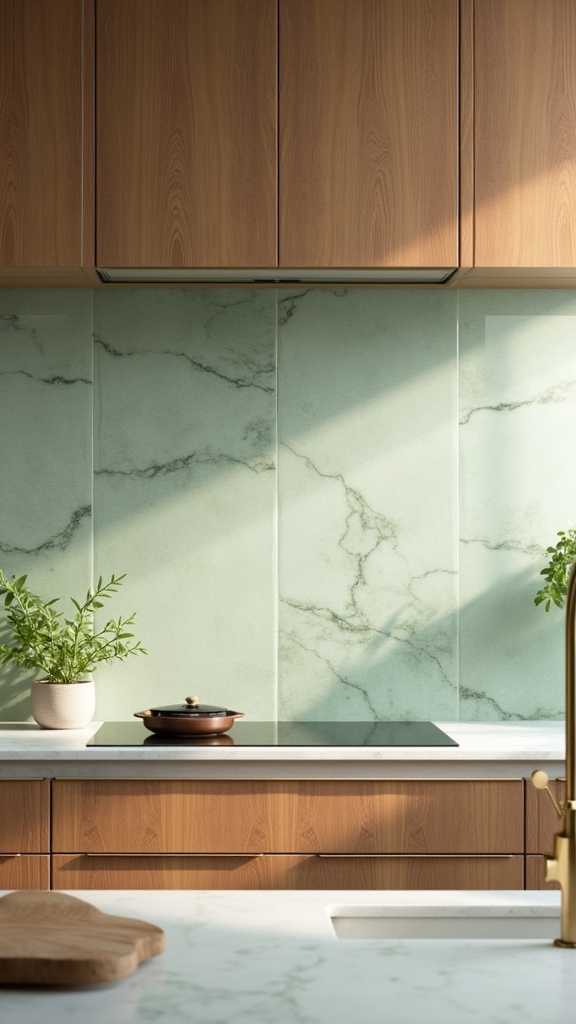
When introduced as backsplash tiles, sage green infuses the kitchen with a refined, contemporary edge that anchors the design scheme.
Sage green backsplash tiles offer a striking juxtaposition against neutral cabinetry and countertops, instantly elevating visual interest. The choice between matte and glossy finishes amplifies the tactile dimension, ensuring the backsplash stands as a focal point.
Sage green backsplash tiles create bold contrast with neutral cabinets, while matte or glossy finishes transform the backsplash into a stunning focal point.
Integrating natural materials such as wood or stone alongside sage green tiles enhances the earthy ambiance, creating a seamless shift between organic and modern elements.
For those seeking a playful yet sophisticated accent, patterned sage green backsplash tiles introduce dynamic movement while retaining cohesion.
- Select matte or glossy sage green tiles for nuanced texture.
- Pair with wood or stone for an organic, grounded feel.
- Experiment with patterns to subtly energize the backsplash.
Accessorize With Sage Green Appliances and Decor

Incorporating stylish sage green gadgets—such as stand mixers, kettles, and toasters—serves as both functional upgrades and visual focal points within the kitchen environment.
Coordinated kitchen textiles, including towels, oven mitts, and seat cushions, reinforce a unified palette while introducing soft, textural layers.
This approach aligns with current design trends favoring curated accents that offer both versatility and effortless seasonal updates.
Stylish Sage Green Gadgets
A curated selection of sage green appliances—such as toasters, blenders, and coffee makers—immediately enhances the visual harmony of a contemporary kitchen, reinforcing its organic palette and tranquil ambiance.
In current design trends, these small yet impactful gadgets deliver a sophisticated infusion of color while supporting a cohesive, earthy aesthetic. The subtle shade of sage green appliances creates a calming undertone, ideal for those seeking a serene culinary environment.
Additionally, their strategic integration allows for aesthetic flexibility, elevating the space without necessitating major renovations. For an expertly styled kitchen, consider the following:
- Sage green stand mixers or blenders for a statement-making countertop.
- Sleek toasters and coffee makers in soft green hues for coordinated daily rituals.
- Matching sage green utensils or cookware to unify the visual narrative.
Coordinated Kitchen Textiles
By integrating sage green textiles alongside thoughtfully chosen appliances and decor, designers achieve a seamless visual continuity that defines contemporary kitchen aesthetics.
Coordinated kitchen textiles—such as hand towels, oven gloves, and seat cushions in sage green—introduce warmth and tactile interest, complementing sleek appliances like mixers or toasters in harmonious hues.
The strategic pairing of sage green tableware and dishware further refines the unified palette, fostering an immersive, curated dining atmosphere.
Sage green window treatments diffuse natural light, enhancing the kitchen’s serene, inviting ambiance.
For added visual and textural sophistication, mixing coordinated kitchen textiles in linen or cotton amplifies the earthy undertones and promotes a relaxed, fresh vibe.
This approach exemplifies the current trend toward cohesive, nature-inspired kitchen environments.
Combine Sage Green With Earthy Neutrals
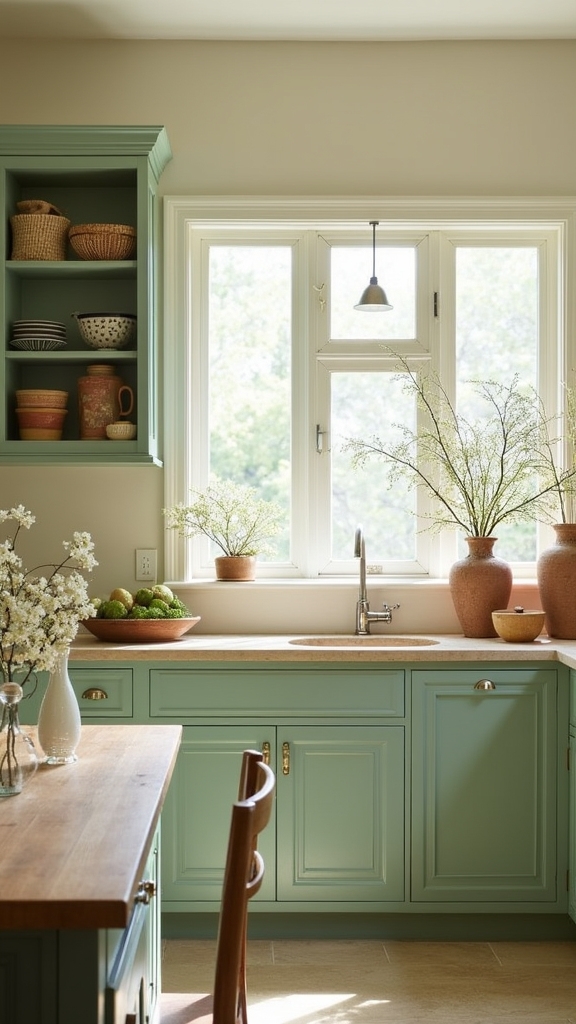
When paired with earthy neutrals such as beige, cream, and terracotta, sage green enhances kitchen design by introducing a harmonious palette that is both on-trend and timeless.
This blend fosters a serene environment that feels organic yet sophisticated, with the muted green acting as a focal point against understated backdrops.
Expert integration of natural materials—wood cabinetry, stone countertops—deepens the connection to nature, while soft neutral surfaces visually expand the space and promote tranquility.
Earthy neutrals allow sage green to stand out without overwhelming, achieving a balanced, elegant aesthetic ideal for modern kitchens.
- Combine sage green cabinetry with terracotta tile or beige stone flooring for visual warmth.
- Use cream countertops to highlight sage green accents and enhance openness.
- Incorporate wooden shelving for additional organic texture and cohesion.
Layer Different Green Shades for a Cozy Look

Layering green tones—such as pairing airy sage with moody olive and striking emerald accents—cultivates a multidimensional, cocooning effect in the kitchen.
This chromatic interplay, when balanced across cabinetry, walls, and decor, aligns with current biophilic and color-blocking trends.
Strategic juxtaposition of light and dark greens not only defines zones but also enhances spatial depth and tactile interest.
Mix Light and Dark
While a monochromatic approach can feel flat, introducing both light and dark green shades—such as pairing soft sage with deep forest tones—infuses the kitchen with sophisticated depth and visual intrigue.
Design experts recommend layering light and dark greens to establish a dynamic, cohesive palette that enhances the space’s ambiance. Lighter greens on walls or upper cabinetry reflect natural light, fostering openness, while darker greens on lower cabinets or accent walls ground the room and accentuate architectural details.
This interplay of tones not only enhances organic textures, such as wood and stone, but also resonates with current trends favoring earthy, inviting kitchens.
- Layer light sage on cabinetry with deep forest green accents for visual hierarchy.
- Highlight natural materials by pairing contrasting green tones.
- Integrate metallic or neutral accessories for a balanced finish.
Blend Sage With Olive
Building on the dynamic interplay of light and dark greens, blending sage with olive introduces a refined spectrum that envelops the kitchen in warmth and comfort.
This layered approach to green pigment raises the ambiance, forging a harmonious and inviting atmosphere that’s both fresh and grounded.
Sage green cabinetry or walls, when punctuated with olive accents—think paneling, open shelving, or even upholstered seating—creates seamless chromatic changes, enhancing depth and visual intrigue.
The use of natural materials such as wood and stone amplifies this effect, reinforcing the rustic, organic sensibility that is increasingly favored in contemporary kitchen design.
Accent With Emerald Hues
Emerald accents, when juxtaposed with sage green cabinetry or walls, introduce a compelling depth and visual harmony to the kitchen’s palette.
This expert layering of green hues not only adds depth but also fosters a strong connection to nature, a hallmark of modern, biophilic design trends.
Rich emerald green tiles, decor, or accessories provide a striking contrast, transforming your home’s kitchen into an inviting, sophisticated space that feels both fresh and timeless.
- Emerald Barstools: Positioning emerald-toned barstools near sage green cabinetry creates a seamless yet energetic shift between shades.
- Statement Lighting: Select emerald glass pendants or fixtures to add visual interest and build on the natural theme.
- Artful Decor: Integrate emerald-accented wall art or ceramics for cohesive, curated elegance.
Use Sage Green in Farmhouse and Country Kitchens

Embracing sage green in farmhouse and country kitchens introduces a sophisticated yet grounded palette that harmonizes effortlessly with natural wood elements.
Sage green cabinetry juxtaposed with wooden worktops amplifies the rustic essence intrinsic to these kitchen styles, cultivating an inviting and tactile environment. This verdant hue, when applied to walls or as subtle accents, promotes tranquility and a seamless flow, echoing the calming tones of the countryside.
Sage green cabinets paired with wooden worktops invite rustic warmth and tranquility, echoing the soothing palette of the countryside.
Integrating nature indoors is further enhanced by the strategic placement of potted herbs and foliage, reinforcing a fresh, lived-in ambiance.
Vintage-inspired taps and brass fixtures in sage green kitchens infuse understated elegance, while respecting the authenticity of farmhouse design. This approach remains at the forefront of kitchen trends, balancing modern appeal with timeless rural character.
Highlight Sage Green in Modern and Minimalist Designs
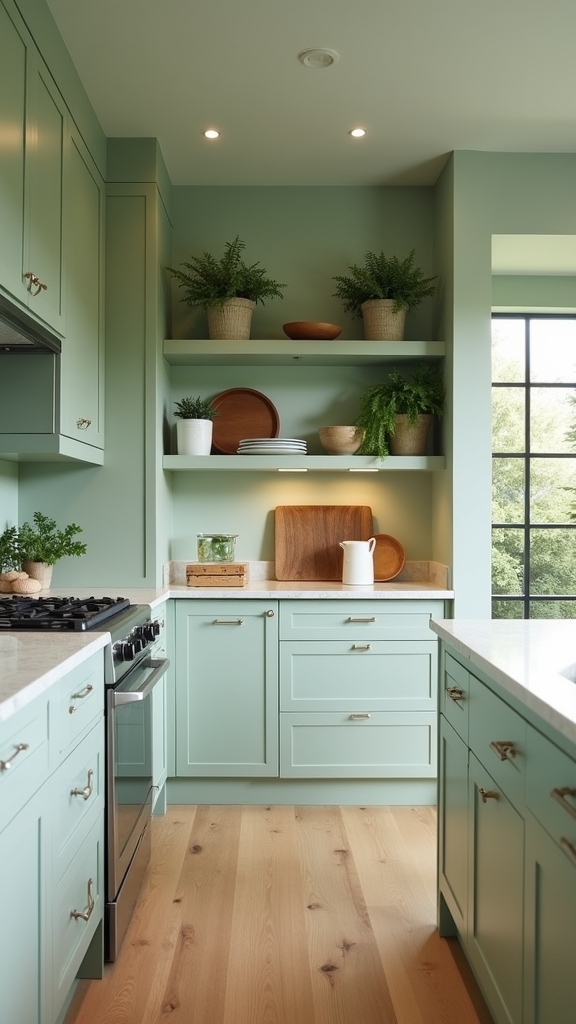
A growing number of contemporary kitchens leverage sage green to define modern and minimalist aesthetics, utilizing its muted, versatile tone to cultivate an atmosphere of tranquility and refined simplicity.
Sage green cabinetry is a cornerstone in these spaces, offering a fresh yet understated focal point that complements streamlined architecture and open layouts. The integration of sleek, matte finishes further enhances the subtlety and sophistication prized in modern and minimalist designs.
Strategic use of this hue guarantees a balanced interplay between color and negative space, highlighting both functionality and elegance.
- Contrast sage green cabinetry with crisp white walls for a striking, modern visual.
- Pair sage green with light woods and white marble for cohesive, organic elegance.
- Incorporate sage green accessories to introduce color without disrupting minimalist harmony.
Add Subtle Luxury With Gold or Bronze Hardware
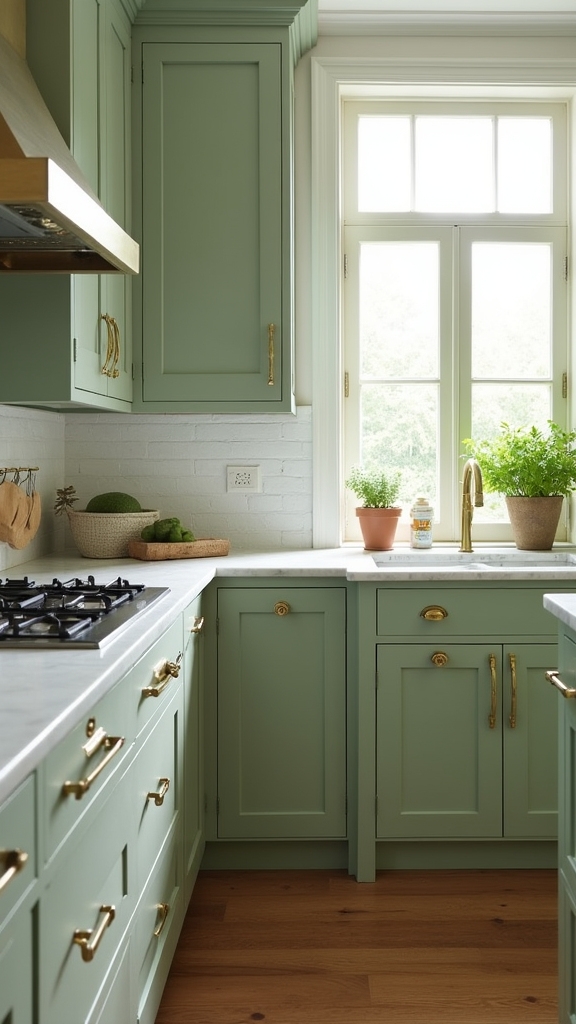
Many designers turn to gold or bronze hardware to impart understated opulence to sage green kitchens, capitalizing on the warmth and sophistication these metallic accents provide.
Gold handles, in particular, offer a striking visual counterpoint against the muted, earthy tones of sage cabinetry, instilling the space with a sense of refined luxury.
Brass finishes are favored in traditional or country-style kitchens, infusing a vintage sensibility that enhances the timeless appeal of sage green.
For a cohesive palette, bronze light switches and sockets introduce subtle retro undertones without overpowering the scheme.
Selecting taps and hardware in warm metallics—especially gold—elevates the design, enriching depth and balancing contemporary minimalism with classic influences.
This nuanced approach guarantees a harmonious blend of modern and vintage aesthetics.
Frame the View With Greenery and Biophilic Elements
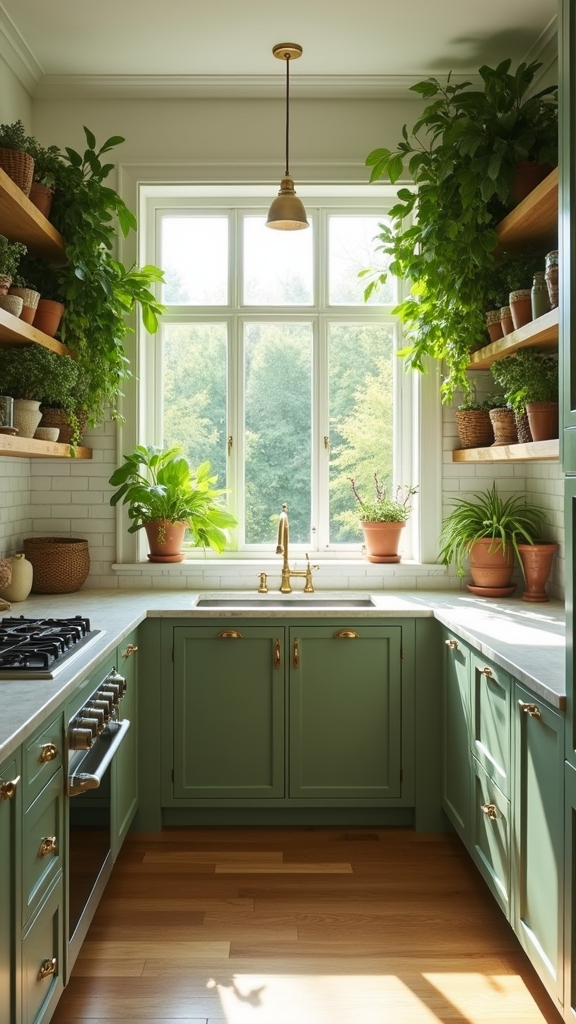
While sage green kitchens already evoke a sense of tranquility, layering in biophilic elements intensifies the connection between the interior and the natural world.
Expert designers increasingly frame the view with greenery to foster a visually expansive and serene environment. Strategic placement of indoor herb gardens, potted plants, or hanging planters not only introduces organic silhouettes but also improves air quality and culinary functionality.
Integrating sage green with natural materials—such as wood and stone—enhances the overall harmony, blurring the boundary between kitchen and surroundings. For maximum impact, expansive windows or glass doors act as biophilic elements, allowing outdoor vistas to become part of the interior palette.
- Incorporate a living herb garden for beauty and utility.
- Frame windows with cascading greenery.
- Use natural textures in tandem with sage green cabinetry.
Frequently Asked Questions
What Color Compliments Sage Green Kitchen?
When selecting complementary colors for a sage green kitchen, designers favor soft neutrals like ivory, rich hues such as deep navy, warm metallics, earthy terracotta, and pastel accents, reflecting current trends toward balanced, inviting, and visually harmonious interiors.
Is a Sage Green Kitchen Timeless?
Evaluating kitchen longevity, experts recognize that sage green’s muted sophistication and adaptability to evolving Sage Trends guarantee its timeless appeal. Its synergy with natural textures and complementary hues allows kitchen designs to remain visually relevant across design movements.
What Color Flooring Goes With Sage Green Kitchen Units?
When considering Flooring Options for sage green kitchen units, experts recommend light wood for warmth, dark stone for contrast, cream tiles for subtlety, terrazzo for texture, or polished concrete for a modern, trend-forward aesthetic that enhances visual harmony.
What Countertops Look Best With Sage Green Cabinets?
Selecting countertop materials for sage green cabinets, designers favor white marble for crisp contrast, creamy granite for warmth, or light oak wood for organic appeal. Matte finishes heighten subtlety, while dark quartz introduces a modern, dramatic visual statement.
Conclusion
Sage green kitchens epitomize contemporary sophistication, merging biophilic design with enduring elegance. This nuanced hue harmonizes with natural woods, metallic accents, and lush greenery, creating spaces that feel both grounded and invigorating. Whether featured in modern minimalism or rustic farmhouse settings, sage green serves as a versatile foundation for innovative layouts and curated materials. As kitchen trends evolve toward earthier palettes and tactile finishes, sage green remains a timeless choice for those seeking understated luxury and organic tranquility.
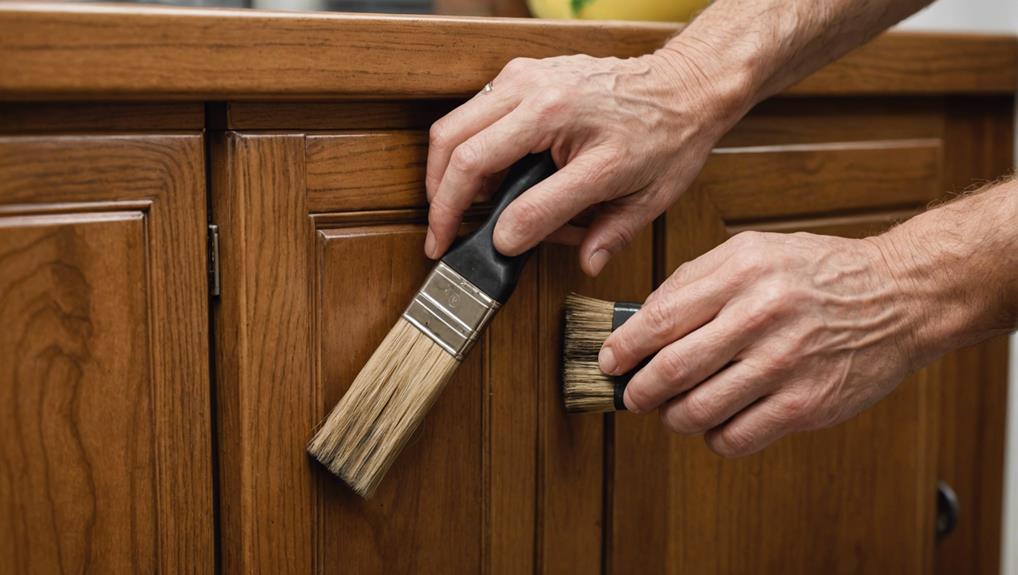
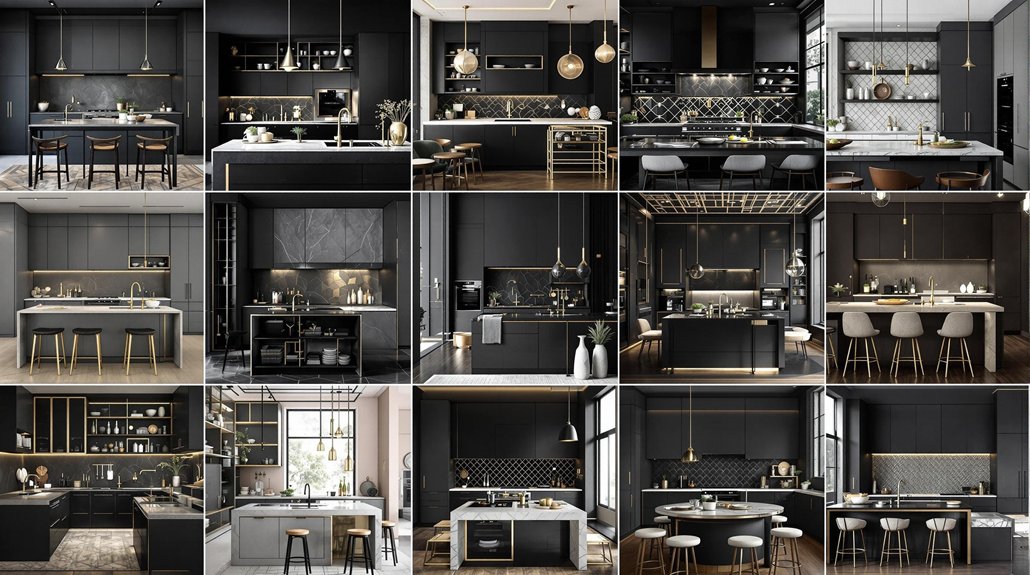
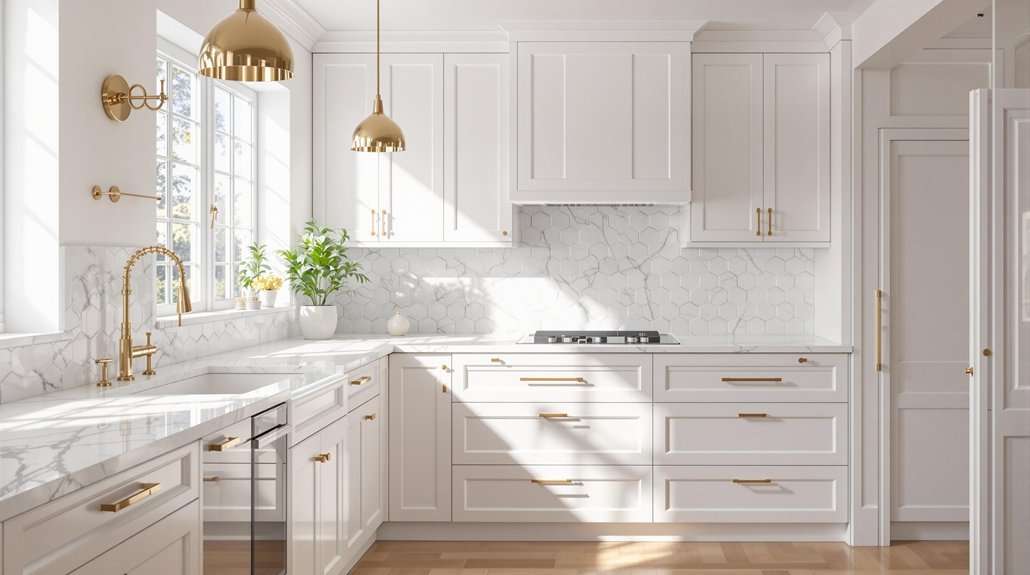
Leave a Reply